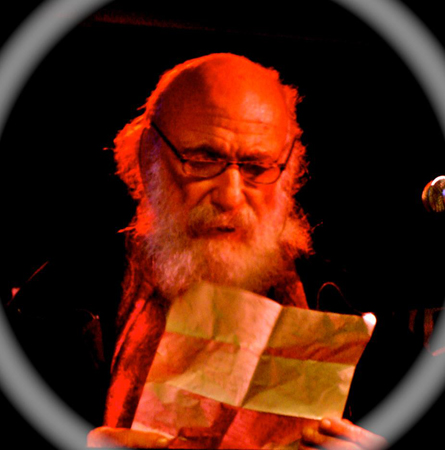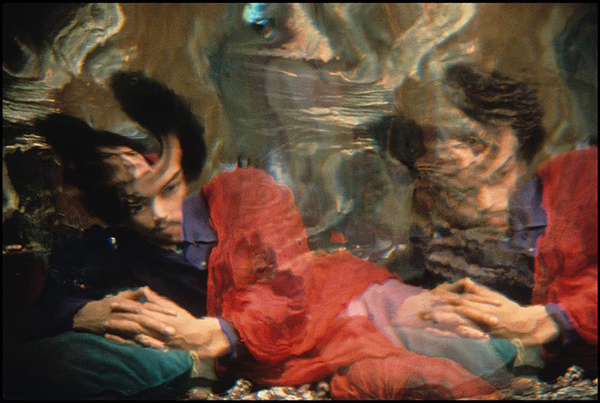Ira Cohen, Psychedelic Jester
Valery Oisteanu
June 2017
 Ira Cohen, 2003, photo by Valery Oisteanu
Ira Cohen, 2003, photo by Valery Oisteanu
The word “psychedelic” means “mind manifesting,” and it was first coined by British psychologist Humphry Osmond. As a malevolent jester, Ira Cohen was a rare species of urban shaman who used the inner world of his own psyche to conjure a repertoire of images representing gurus of the Kabbalah/Sufi/Buddha, all informed by a unique New York City-style vitality.
Vintage psychedelic visual arts were a counterpart to psychedelic rock music and psychedelic states of consciousness in poetry, theater and dance, and Ira moved through all of these dimensions with his camera, his magic pipe and his wise-ass attitude.
Ira appeared on my radar screen in 1973 in Kathmandu, Nepal, in a restaurant frequented by westerners, holding court with teachings about opium eating as a medicine, and the preparation of majoon — a confection made with hashish. He looked like a western guru in long dark robes, a hybrid kabbalist in training/beat poet in exile, on a trip of illumination throughout India and Nepal in the footsteps of his elders: Charles Henri Ford, Allen Ginsberg, Gary Snyder, Peter Orlofsky, Angus McLees and Joanne Kyger.
The beatniks recognized the role of psychedelics in their role as sacred inebriants practicing Native American religious rituals. They also had an understanding of the philosophy of the surrealist and symbolist poets who called for a “complete disorientation of the senses” (to paraphrase Arthur Rimbaud). They knew that altered states of consciousness played a role in Eastern Mysticism; they were hip to psychedelics as psychiatric medicine. LSD was the perfect catalyst to electrify their far-out melange of ideas into a cathartic, mass-distributed panacea for the soul of the succeeding generations.
And Ira was a part of it. At this crucial juncture he found his guru, Ganesh Baba, a pioneering psychedelian holy man from Nepal/India, and the rest is history — the history of avant garde experiments in photography, poetry and performance, spiritual healing and the very living of a post-beat lifestyle.
As a poet, in 1974 he jumped from the printed page to printed parchment with wood-print blocks, and then to rice paper, publishing himself and his friends Gregory Corso, Angus McLease, Paul Bowles, Charles Henri Ford and others.
Ira and I reconnected in 1977 in New York, at the Chelsea Hotel (where else?) in the company of Bill Wolak, a poet/collagist with surrealist sympathies. We began a feisty collaboration on small publications such as The Dream Helmet (Somniloquist Press, 1977). We operated under a code that held we would publish and read only with friends of like mind. We recited our poetry together at La Mama Galleria, TNC, St. Marks Church, The Knitting Factory.
Meanwhile Ira’s photography and poetry, sometimes in tandem, continued to appear in literary magazines such as Dream Helmet, Nexus and Big Bridge. Like his photography, his poetry flows with psychedelic fluidity, in this case chiming with the chanting rhythm of the music of Joujouka as darkened by a nightmarish coda.
In the early 1980s, at a time when I was a guest editor for New Observations, I commissioned an article about the “golden” era from Ira. In his words:
In 1970 I left New York and the Mylar Chamber where I was photographing archetypal images in bendable mirrors of friends and fellow artists such as Jimi Hendrix, William Burroughs, Jack Smith and Charles Ludlam. Suddenly the Sixties were over, and I decided to leave on a real journey with India and Nepal as a final destination. After many months of travel (stopping in Morocco, Tunisia, Afghanistan and India), Petra Vogt and I finally made our way to Kathmandu, where we were to remain for the better part of a decade. We intended a brief visit but fell under the spell of this Shangri-La in the Himalayas, where it was not difficult to believe that, as long as we remained, we would stay young forever writing poems touched by the magic of high tantric strivings under the blue cloud-filled skies, there at the top of the world.
Ira was a practitioner of the surrealist photography of distortions similar to Andre Kertesz, an elder contemporary and a master of mirror distortion in photography. But Ira introduced richly saturated psychedelic colors in glaring contrast, as if trippy trompe l’oeil illusions.
His theatrical set-up and fluidity allowed his objects to morph and become new surrealistic spectacles on a biomorphic stage. Melting faces are still recognizable: William Burroughs floats above with an anguish air, Jimi Hendrix’s double image echoes upon itself, as another Jimi gazes into his own distorted image, self-analyzing the loneliness. Many of his works are a swirl of psychedelic colors and Freudian portraits depicting double-personalities morphed into a retro burlesque style.
All at once an impresario, a stage director, a costume and paraphernalia stylist, Ira ultimately was the reporter of an era now gone and mostly forgotten. Some of his mylar works were later used as pop advertising posters by Jack Smith and as album covers by rock bands and jazz musicians, and for his own CD, The Poetry of Ira Cohen (Subrosa).
Ira passed away in 2011 at age 76, creative to the end. His Mylar dreams are still with me.
 Jimi Hendrix by Ira Cohen in Mylar Chamber 1969-1970
Jimi Hendrix by Ira Cohen in Mylar Chamber 1969-1970
Valery & Ruth Oisteanu Collection
Where the Heart Lies
Throw it out the window & it’ll
come in the door.
John LaTouche to Brion Gysinfor Brion Gysin,
the original blue eyed sailor
of the Sahara
Welding your ship w/ rivets of
Japanese calligraphy
you tack your sails of smoke & rise
like the golden eagles of Fabergé
stolen from the blunted Edge of
a Tangier fantasy
There will never be another
who wld so dare to rub out the sky’s blue
& yet remaining sure of ownership,
await the unbridled cloud’s
inevitable return
See the Moroccan acrobats
turning cartwheels on the traintops
of your memory
passing like wind
in the hair of another
But then the desert always advancing
moves inexorably to devour the grasslands
taking the green
as you have taken
the blue
on the end of yr brush
making the walls of this world
into open skies
for other ships
to sail thru
Under the sign of the Three Hammers
yr cylinder keeps turning
removing impurities
before the final mutation
The man on the trapeze has filched
yr wallet,
a priest not yet defrocked
dreams of Bencharki
& now in your eyes
blue as the sky
you have stolen
I see the vandalized pages
of vellum
as they arrange themselves before you
O Fugitive Resonance,
in the absence of turnstiles
your windows are always OPEN.Alien Poem
Sometimes I feel like you don’t exist,
my hair separates me from the universe
of shadow analysis
I would prefer to watch the waves
overlap on a distant screen
than deal w/the emotions you arouse
in me
I walk down Black Hand Alley thinking
on that perfect light – O dot of gold
which unbewilders the very darkest night,
perhaps the confusion began w/language
I always thought that I was plural,
for example,
and that We were singular in deed –
Light illuminates & reveals
and let by love we seek the light
which no hands can hold nor any eye
repeal
This I thought while walking late at
night
when I found my heart crushed
beneath your heel.from The Stauffenberg Cycle & Other Poems, Amsterdam School, poetry series, bilingual/Tweetalig, 1981, edited by Eddie Woods and Hennie Jetzes
Poster Poetry Project, 1980
Valery Oisteanu & Ira Cohen (photoshop Ljuba Ristic)
Links to:
Ira Cohen: psychedelic photography master – in pictures, The Guardian
A short excerpt from Invasion of the Thunderbolt Pagoda on The Wire Magazine
Ira Cohen in conversation with Harold Hudson Channer, video interview
Kathmandu Dream Piece,audio, prose piece written for the first issue of Ins & Outs magazine
